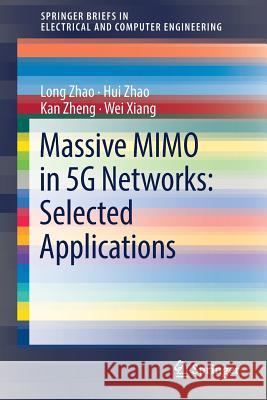Massive Mimo in 5g Networks: Selected Applications » książka



Massive Mimo in 5g Networks: Selected Applications
ISBN-13: 9783319684086 / Angielski / Miękka / 2018 / 93 str.
This SpringerBrief focuses mainly on the basic theory and applications of massive MIMO in 5G networks.
1 Overview (about 10 pages)
1.1 5G Brief
1.1.1 5G Requirements
1.1.2 5G Technology
1.2 MIMO Technology
1.2.1 MIMO
1.2.2 Massive MIMO
1.3 Aim of Monograph
References
2 Massive MIMO Technology (about 25 pages)2.1 Application Scenarios
2.1.1 Homogeneous Network Scenarios
2.1.2 Heterogeneous Network Scenarios
2.2 Physical-Layer Performance
2.2.1 Spectrum Efficiency
2.2.2 Energy Efficiency
2.2.3 Reliability
2.3 Networking Technology
2.3.1 Inter-Cell Interference Coordination
2.3.1 Scheduling Strategy
2.4 Summary
References
3 Massive MIMO-Aided Millimeter Communication Networks (about 20 pages)3.1 Background
3.2 Deployment of Millimeter Communications
3.2.1 Typical Deployment Scenarios
3.2.2 Frame Structure
3.3 MAC and Networking Design
3.3.1 Routing in multi-hop HetSNets
3.3.2 Access control and interference coordination3.3.3 mm-wave Softcell Concept
3.4 Performance and Discussions
3.5 Summary
References
4 Massive MIMO-Assistant Energy Transfer Networks(about 20 pages)4.1 Background
4.2 Downlink Hybrid Information and Energy Transfer
4.2.1 Downlink HIET System Model
4.2.2 Power Allocation Problem for HIET System
4.3 Power Allocation of Single Cell Scenario
4.3.1 Power Allocation with Perfect CSI
4.3.2 Power Allocation with Estimated CSI
4.3.3 Performance Evaluation4.4 Cooperative Energy Transfer of Multi-Cell Scenario
4.4.1 Centralized Energy Precoder
4.4.2 Distributed Energy Precoder
4.4.3 Performance Evaluation
4.5 Summary
References
5 Conclusion and Outlook(about 5 pages)5.1 Conclusion
5.2 Future Research Directions
References
Long Zhao is currently a lecturer of Beijing University of Posts and Telecommunications (BUPT). He got his B.S, M.S. and Ph. D degree from China in 2008, 2011 and 2015, respectively. He was a research scholar in Engineering School of Columbia University, US from Apr. 2014 to Mar. 2015. He joined BUPT in 2015 as lecturer. His research interests are Smart Communications and Massive Signal Processing. He has published more than 40 papers in significant journals and international conferences. Hui Zhao is currently an associate professor in Beijing University of Posts and Telecommunications (BUPT), China. She received her M.S degree in 2003 from Tianjin University and Ph.D. degree in 2006 from Beijing University of Posts and Telecommunications (BUPT). She has published more than 50 papers as well as patent applications, and has taken part in a large number of research projects. Her research interests include 5G communications, intelligent hardware and green communications.
Kan Zheng is currently a professor in Beijing University of Posts &Telecommunications (BUPT), China. He received the B.S., M.S. and Ph.D degree from, China, in 1996, 2000 and 2005, respectively. He is author of more than 200 journal articles and conference papers in the field of communication signal processing, resource optimization in wireless networks, M2M/V2V networks and so on. He holds editorial board positions for several IEEE/non-IEEE journals. He has organized several special issues in famous journals. He has also served in the Organizing/TPC Committees for more than 20 conferences such as IEEE PIMRC, IEEE VTC and so on. Wei Xiang is currently a professor of James Cook University, Cairns, Australia. He received the B.Eng. and M.Eng. degrees, both in electronic engineering, from the University of Electronic Science and Technology of China, Chengdu, China, in 1997 and 2000, respectively, and the Ph.D. degree in telecommunications engineering from the University of South Australia, Adelaide, Australia, in 2004. During Aug. 2012 and Mar. 2013, He was an Endeavour visiting associate professor at the University of Hong Kong. He received the Best Paper Award at 2011 IEEE WCNC. His research interests are in the broad area of communications and information theory, particularly coding and signal processing for multimedia communications systems.1997-2025 DolnySlask.com Agencja Internetowa
KrainaKsiazek.PL - Księgarnia Internetowa









